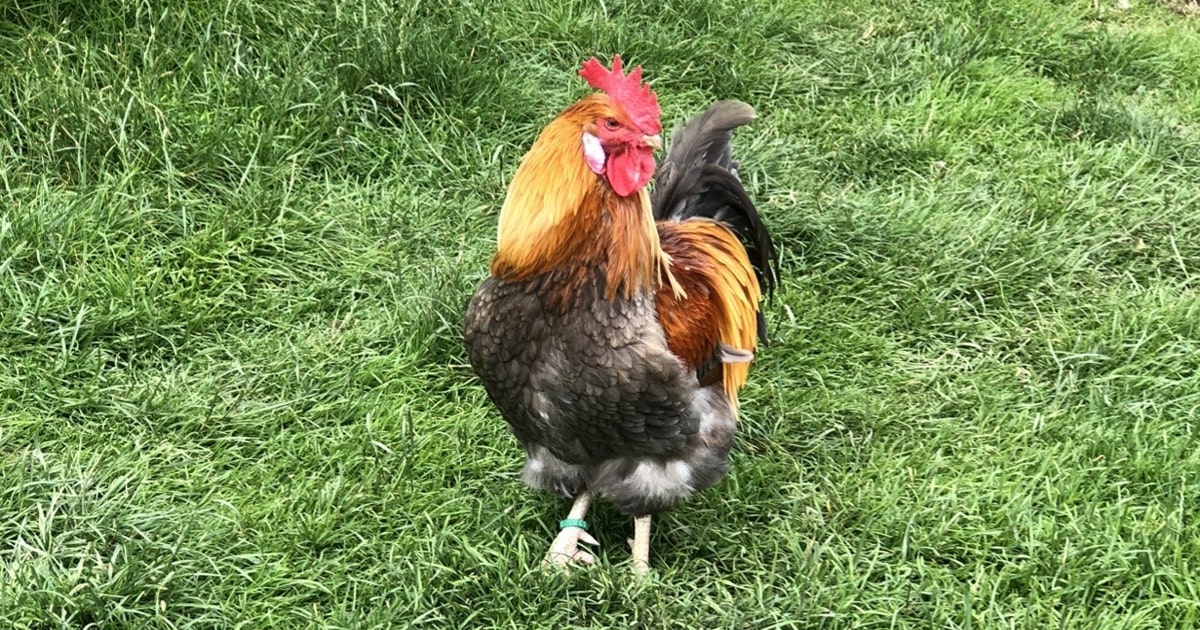Feeding Jupiter and His Harem of Chickens
How I put the circular economy into action – and created a lot of social interaction. An end-of-summer reflection from France’s Dordogne.
September 9, 2023

Two old friends are visiting me, one from London, and the other from Berlin. Not really accustomed to country life, they are making serious inroads into my chicken coop every day.
Why? Because they cannot get over their happy surprise at the deep yellow color of the soft-boiled eggs which we consume each morning. Or, for that matter, the variety of size and shapes that my hens, of various breeds, deliver.
Most of all, they are surprised when I tell them they are eating the output of second-hand leftovers. What few people realize, when it comes to the diet of free chickens in the French countryside, anything goes.
The circular economy – in my yard and my kitchen
As far as my own yard is concerned, all plums, pears and apples that get bruised when they fall to the ground before I have been able to pick them go to the chickens.
I apply the same circularity principle in my kitchen. All potato peelings, onion skins, tops and tails of carrots, cucumber skins, melon rinds and seeds, fat trimmings off the ham, barbecued ribs with some shreds of meat still attached, cheese rinds, stalks of mushrooms, orange peel and apple cores all go to the chickens. As does stale bread, which the chickens devour too. However, it is soaked first.
The circular economy force multiplier
A few nights ago, we went down to our village’s weekly night market. Every Tuesday night in July and August, about five hundred people gather at the tables and benches in the square by the river, with a space for dancing later, and all around the rim were the food stalls.
There, the visitors from all over Europe are, of course, offered all the classic French country foods. These includes roast beef, lamb, pork and duck, fresh-grilled fish and prawns along with flash-fried foie gras, pommes frites and huge tomato and cucumber salads.
In addition, they are offered a remarkably international spread of cuisines by local vendors. They ranges from Thai food, German pizzas called “Flammkuchen,“ Caribbean food from Guadeloupe and Indian vegetarian curries to flame-grilled hamburgers, ice creams, apple tarts and dozens of different cheeses.
My green thumb in action at the night markets
What my friends had not expected was that, once we had finished eating, I would pull out two large heavy-duty plastic bags that I keep for these occasions. Somewhat puzzled, they asked what I planned to do with those bags. After all, they were far too big just for our own leftovers.
Off I went on my excursion along the many rows of tables where many other visitors, just like us, had completed their dining experience.
Systematically, I went along all the rows of benches looking for leftovers. I asked politely in French for any “déchets“ (i.e., leftovers), explaining that it was “pour mes poules.“
Among the French this causes little surprise. However, the Dutch, British and German tourists are usually startled by my request. But most of them soon enough get into the spirit and start loading the bread crusts, cold French fries, remnants of salads and churros, as well as unfinished, melted ice creams and everything else from their table leftovers that is edible into the sacks.
Politicians as chickens
When the evening is over, I empty the heavier of the two bags into the main chicken coop where the mature females live with their cockerel, Macron, so named for the French President (the previous rooster was called “Sarko,“ for President Sarkozy).
He came with four wives. The pretty one was named for his wife, Carla Bruni. Sarko’s second wife was the bully in the chicken coop. Always the first to eat, we called her Margaret Thatcher.
The third never stopped clucking, so she became Hillary Clinton, and the fourth laid the most eggs, so we called her Angela Merkel.
Recycling’s magic action
The second bag is emptied into the smaller coop, that is at once the maternity ward, nursery and kindergarten for the newborn and young chickens who will eventually be moved into the big girls’ coop.
It is also home to two motherly old hens and a couple of pheasants who found their way in by accident. But that is another story.
By the time we wake up in the morning, the heaped piles of leftovers have all gone. Even so, the hens and chickens still want their morning feed of cracked maize.
And, in return, they leave the finest eggs we have ever tasted. They are white or brown, speckled or uniform, round or oval in shape, but each comes with the glorious sunshine-soaked golden yolk that feels like the richest food of all.
Takeaways
To put the circular economy into action in a very practical manner, I collect the food leftovers from the many rows of fellow diners at the night markets in my Dordogne village.
Collecting food for my chickens usually startles the Dutch, British and German tourists at the night markets in Dordogne. But soon most of them get into the spirit and start loading their leftovers into my bags.
Practicing the circular economy on behalf of my chickens yields the finest eggs, each with the glorious sunshine-soaked golden yolk that feels like the richest food of all.

